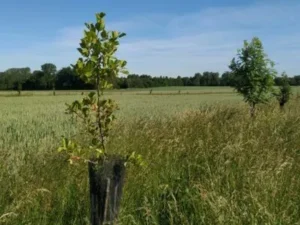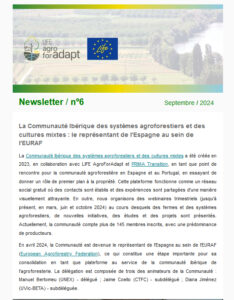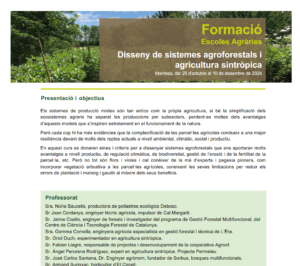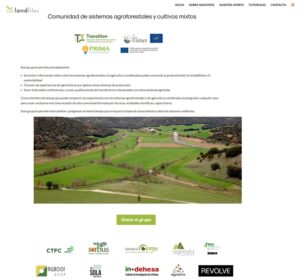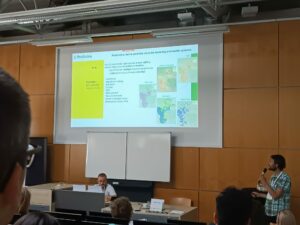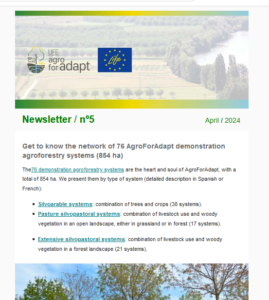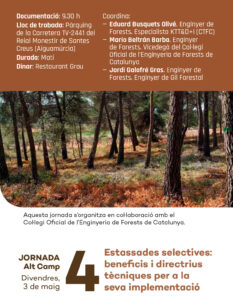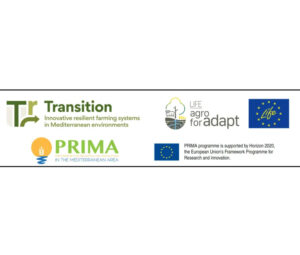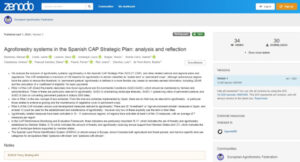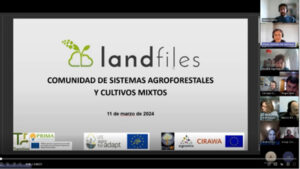Iberian Agroforestry Systems Community: 3rd webinar + Youtube channel
The Iberian Community of Agroforestry Systems and Mixed Crops is a thematic social network that seeks to promote the exchange of information between agroforestry farmers, consultants, practitioners, researchers and administrations. In addition, we hold a quarterly webinar (we have already held three sessions), with a new feature: we have created a Youtube channel so that […]
Sixth biannual newsletter (September 2024) online
The sixth edition of the biannual newsletter AgroForAdapt is now available. In this issue we present the appointment of the Community of Agroforestry Systems and Mixed Crops as representative of Spain in EURAF (European Agroforestry Federation), the technical trip to France in May 2024, the 5 communications made by the project at the European Agroforestry […]
This autumn, learn about agroforestry systems
The Agricultural School of Manresa (Barcelona, Spain) is organizing a 36-hour course on agroforestry systems and syntrophic agriculture. The AgroForAdapt partners are participating in two of the sessions, on 12/11 and 10/12. The program and registration instructions are available at this link.
The Iberian Community of Agroforestry Systems and Mixed Crops, Spain's representative in the European Agroforestry Federation
The Iberian Community of Agroforestry Systems and Mixed Crops is a thematic social network created in 2023 to connect people interested in this type of production systems. Agroforestry systems integrate trees on agricultural or livestock land, while mixed crops combine two or more agricultural and livestock productions in the same space. This Community, which is […]
AgroForAdapt, at the 7th European Agroforestry Conference!
From 28th to 31st May we have participated in the 7th European Agroforestry Conference, the biannual meeting point of the continental agroforestry family, organised by EURAF, the European Agroforestry Federation. This edition was held in Brno (Czech Republic), with 400 participants. AgroForAdapt has been represented in five communications: - Coello J, Durante P, Tejedor R, […]
Fifth Newsletter (April 2024) online
The fifth edition of the biannual newsletter AgroForAdapt is now available In this issue we present the 76 demonstration agroforestry systems of the project (854 ha), the first webinar of the Iberian Community of Agroforestry Systems and Mixed Crops, the study "Agroforestry systems in the Strategic Plan of the Spanish CAP: analysis and reflections", as well […]
Technical seminar on selective shrub clearing
On Friday 3 May we will present the challenge of selective thinning (reduction of scrub density) to maintain the most interesting shrubs for the forest ecosystem: scarce species, those with special interest for the conservation of biodiversity and/or with forage interest. This conference will be held in the Aiguamúrcia forest (Tarragona, Spain), an AgroForAdapt demonstration […]
The Community of agroforestry systems and mixed cropping, an application highlighted by the Agromix project
The Iberian Agroforestry and Mixed Farming Community has been highlighted by the Agromix project as a relevant innovation for the agroforestry sector, in the article: "Cultivating connections: the growth of thematic social networks in agroecology". This thematic social network specialised in agroforestry systems has been created by the LIFE AgroForAdapt and PRIMA Transition projects, and […]
Study "Agroforestry systems in the Spanish CAP Strategic Plan: analysis and reflections".
In recent months we have collaborated with various projects and entities to describe the regulatory framework of agroforestry systems in Spain, in the framework of the new CAP (2023-27). We have completed the analysis with a SWOT analysis (Strengths, Weaknesses, Opportunities, Threats) of this policy framework. The study will be published as a EURAF (European […]
First webinar of the Community of agroforestry systems and mixed crops
The Iberian Community of Agroforestry Systems and Mixed Farming was created in 2023, in collaboration between LIFE AgroForAdapt and PRIMA Transition as a meeting point for the agroforestry community in Spain and Portugal, trying to give a leading role to ownership. In addition to functioning as a social network where images, news and debates can […]

